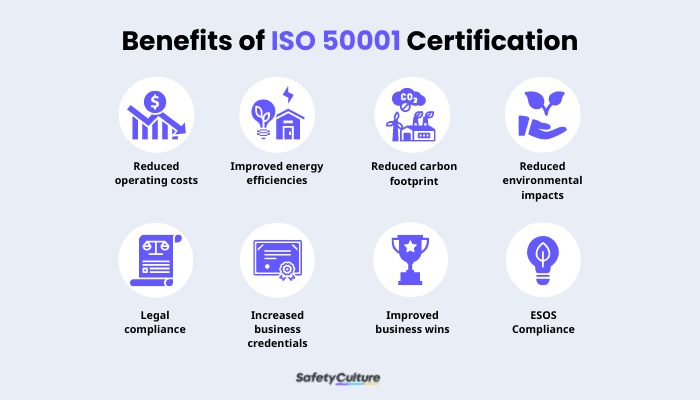What is the ISO 50001 International Standard?
ISO 50001:2018 is an International Standard for Energy Management System (EnMS) containing requirements and guidelines for organizations to follow to optimize energy efficiency and reduce greenhouse gas emissions. This ISO standard is based on the Deming Cycle, consisting of four steps: Plan-Do-Check-Act.
To meet ISO 50001 requirements, organizations must:
- create an energy policy outlining their commitment to energy efficiency;
- set energy performance goals;
- establish procedures for monitoring and measuring energy consumption; and
- take corrective action.
In addition, the standard requires continual improvement of energy performance over time. By following the guidelines outlined in the ISO 50001 standard, organizations can reduce their environmental impact while saving money on energy costs.
What are the Key Elements of ISO 50001?
The key elements of ISO 50001 are as follows:
- Expressing a commitment from top management to improve energy performance and establish an energy policy
- Developing an energy management system that includes setting energy performance improvement objectives, planning actions to achieve these objectives, implementing and operating the steps, and continually improving the system
- Utilizing information and resources to make decisions
- Finding and prioritizing energy efficiency opportunities
- Implementing a systematic approach to improve energy performance, including continual monitoring and improvement of the EnMS
By following these essential elements, organizations can ensure that they can meet the requirements of ISO 50001 and improve their overall energy performance.
Why is Energy Management Important?
The company’s operations rely on energy. Regardless of their activities, this can be a costly factor. Energy management covers the use of energy throughout the organization’s supply chain.
Aside from expenses, energy usage has an impact on climate change. Although searching for alternative energy sources might be time-consuming, every business should aim to minimize energy usage and consumption.
In addition, organizations should seek to raise employee awareness of energy conservation. By attaining ISO 50001 certification, you will gain the skills necessary to help the firm recognize and capitalize on its potential benefits. You will also assist the company in lowering its carbon footprint by becoming recognized as an environmentally responsible business.
Benefits of ISO Certification
ISO certification offers many benefits, including:

Benefits of ISO 50001 Certification
- Reduced operating costs – Increased energy efficiency may result in significant financial savings.
- Improved energy efficiencies – Your company will use less energy to achieve the same output level by improving energy performance.
- Reduced carbon footprint – People will respond well to your company if you actively pursue reducing your carbon impact and become certified.
- Reduced environmental impacts – As your business’s carbon footprint decreases, so will its negative impact on the environment.
- Legal compliance – Recognize how legal and regulatory rules affect your organization and its clients.
- Increased business credentials – Certification by a globally recognized industry standard demonstrates how trustworthy you are.
- Improved business wins – Certification and verification open doors because procurement standards frequently demand it as a requirement to supply.
- ESOS Compliance – It fulfills the requirements of the UK government’s Energy Savings Opportunity Scheme (ESOS) regulations.
Difference Between ISO 14001 and ISO 50001
The primary distinction between ISO 14001 and ISO 50001 is the scope of the standards. Although both standards allow companies to safeguard the environment via policies, objectives, and procedures, ISO 50001 focuses on energy usage, whereas ISO 14001 considers environmental protection.
Consider it in terms of the key criteria of each standard. ISO 14001 focuses on resource usage, waste management, and pollution, whereas ISO 50001 is concerned with energy performance indicators and a company’s energy baseline. ISO 14001 addresses energy use, but only to the extent that it affects environmental performance. ISO 50001, on the other hand, would evaluate energy use by examining equipment, systems, and procedures to determine their influence on poor energy performance.
Another difference is that ISO 50001 requires a more extensive list of documented information than ISO 14001. Examples are the energy planning process, energy reviews, the energy baseline, Energy Performance Indicators (EnPIs), and purchasing requirements.
ISO 50001 can also assist larger businesses with the Government’s ESOS. A UKAS-certified ISO 50001 implementation automatically fulfills its obligations under the program—all that is necessary is for firms to notify the Environment Agency of their compliance.
Is ISO Certification Right for Me?
The ISO 50001 certification is ideal for you and your company if you want to control how you use energy and manage the associated expenditures more successfully. It’s beneficial for businesses that spend a significant amount on electricity.
If you already hold ISO 14001 certification, the basic framework is already in place, allowing you to reap the benefits of ISO 50001. You are already on route to complying with ISO 50001 if you have an existing ISO 14001 environmental management system.
How Do I Get ISO 50001 Certification?
The certification process involves completing a self-assessment against the standard’s requirements, followed by an external audit by a certified assessor. Once certified, organizations must maintain compliance with the standard through regular audits and reporting. Below are the steps to implement and prepare your organization for ISO 50001 certification.
Step 1: Prepare Your Company
First, it is essential to understand what the standard entails and how it needs to be adhered to. You must involve all members of your organization in this process, as energy management affects everyone.
Step 2: Analyze Gaps
Once you understand the standard, you can then compare your organization’s current practices against the requirements of the ISO 50001. Identify and address any gaps using checklists.
Create Your Own ISO 50001 Checklist
Eliminate manual tasks and streamline your operations.
Get started for FREEStep 3: Create a 50001 EnMS Plan
After identifying gaps, you can create an action plan to address them. Plan out how you will implement the standard within your organization.
Step 4: Create a Dedicated Team to Oversee the Plan
The next step is to start putting the plan into action and working toward meeting the ISO 50001 standard. Be sure to track progress and make changes as needed.
Step 5: Train Entire Organization for ISO 50001
As you implement your plan and are making progress towards compliance, it’s essential to train all members of your organization on the standard’s requirements. It will ensure that everyone is aware of their roles and responsibilities.
Step 6: Document ISO 50001 EnMS Plan
As you work towards compliance with the standard, it’s essential to document all of your policies and procedures. It will help ensure that your organization can maintain its compliance.
Step 7: Implement ISO 50001 EnMS Plan
Implement your plan and start working towards compliance with the ISO 50001 standard. Track your progress and make adjustments as needed.
Step 8: Perform an Internal Audit
After implementing your plan, it’s essential to perform an internal audit to ensure everyone follows the policies and procedures. Just like the usual internal assessments that you have aiming to enhance your systems such as product inspection or quality assurance inspection— audits will help identify any areas for improvement where you can focus on.
Step 9: Prepare for ISO 50001 Audit
Once you have completed an internal audit, you should prepare for an external audit by a certified assessor. It will ensure that your organization can demonstrate its compliance with the standard.
Step 10: Apply for Certification
Following completion of these steps, you can apply for certification. Be sure to provide all of the required documentation to the certification body.




